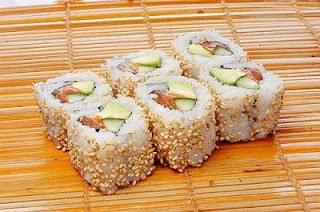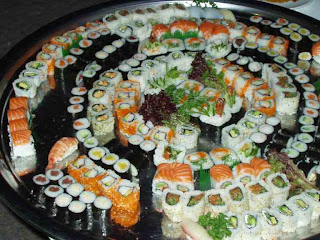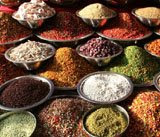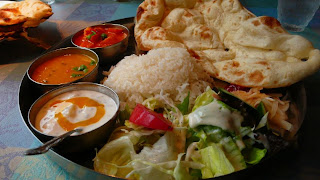
China:
The chinese cooking is one of more renowned to the world, and doubtless who contains most variations. It is rather necessary to speak about the Chinese kitchens because the regional aspect is fundamental. In spite of a remarkable continuity in the history of this cooking, the appearance of regional foods such as we know them today is a rather recent phenomenon, often dating the 19th century.

The Chinese cooking is connected at the same time to the society, to the philosophy and to the medicine.It distinguishes the cai, the cooked vegetables and by extension all which accompanies cereal, fan. Food yin, feminine, wet and soft thus refreshing is vegetables and fruits. Food yang, male, fried, spiced or on base of meat has a warming effect. A meal has to harmonize thus not only the tastes, but also find a balance between the cold and the warmth, the colors and the consistencies. The techniques of the Chinese cooking are so numerous. Another thing characterizing the traditional Chinese cooking is the absence of dairy products because of an intolerance in the lactose which exists in numerous Asian countries.
The Chinese share flats(dishes). These are often shared. The Chinese eat by means of baguettes, or the wooden Chinese spoons, more rarely porcelain. The table is characterized by its social aspect. It is round and sometimes surmounted by a rotating tray where are stored dishes. No knife is present at table. All the food is cut in cooking, with the exception of seafoods which are sometimes served non-peeled.
Thailande:Bangkok, whose real name Krungtep or "City of Angels", in the opinion of many fans of good food, is probably the capital where, for all prices and all nationalities food, you eat the better the planet. A gastronomic universe Thailand, the ancient kingdom of Siam, is, in fact, one of the few Asian countries that has never undergone colonization. In doing so, the foreigner, the "farang", is considered sympathetically and this term has no pejorative connotation ... which is not the case for the "Kwaïlo or Gui Lo" (puppet type) in China. When we accept good heart abroad, we also accept their customs and cuisine. For centuries the Thai cuisine is a melting pot where they have mixed the influences of various cultures of South East Asia ... Siamese, Khmer, Mon, Malay, Indonesian, Vietnamese ... and Far East from China of Japan. Not to mention a very strong Buddhist traditions from India. Become a top tourist destinations in the world, always following the principle of reception, Thailand has also adapted to other crops in a few decades. Everyone will find his account and the largest international hotel to the tiniest Gargote there is a incredible variety of everything he can imagine in terms of food. You will eat better than Lausanne Switzerland, Australia to Sydney to Beijing Chinese, Japanese in Tokyo ... and sometimes French and Paris. It even eats Thai with multiple nuances. This dinner show is very appropriate forRose Garden of the Palace of Midwestern tourists to rural specialties sold, and run by street  vendors around the markets Thonburi. A kitchen fragrant and volatile When it is not watered-down Thai food is exceptionally inventive, fragrant and volatile. It is characterized by the use of herbs, condiments and spices and especially pepper. The latter, described euphemistically as "pepper" (Prik) is no common measure with what is happening elsewhere. The Thai distinguish several varieties starting with the atomic bomb of the kind "Prik kee nu Lueng, tiny and green, followed by" Prik kee nu "which, despite its yellow-orange pastel not want him nothing. After Prik chee fah and Prik yuak which, although regarded as "mild" paralyze you in an instant. The famous Prik Thai equivalent of "bird-pepper" from Martinique, as feared by foreigners, the quality is the sweetest. What is considered inedible by an amateur of harissa is a spicy Thai barely. We understand that the majority of cooks and restaurateurs, especially in the West, have adapted some of their habits to non-regulars. On site, there are, for against, an amoeba ... no certainty, no parasite can resist this shock treatment.
vendors around the markets Thonburi. A kitchen fragrant and volatile When it is not watered-down Thai food is exceptionally inventive, fragrant and volatile. It is characterized by the use of herbs, condiments and spices and especially pepper. The latter, described euphemistically as "pepper" (Prik) is no common measure with what is happening elsewhere. The Thai distinguish several varieties starting with the atomic bomb of the kind "Prik kee nu Lueng, tiny and green, followed by" Prik kee nu "which, despite its yellow-orange pastel not want him nothing. After Prik chee fah and Prik yuak which, although regarded as "mild" paralyze you in an instant. The famous Prik Thai equivalent of "bird-pepper" from Martinique, as feared by foreigners, the quality is the sweetest. What is considered inedible by an amateur of harissa is a spicy Thai barely. We understand that the majority of cooks and restaurateurs, especially in the West, have adapted some of their habits to non-regulars. On site, there are, for against, an amoeba ... no certainty, no parasite can resist this shock treatment. Formerly, the Thais did not use either spoons, or forks, nor knives and ate with fingers the meal put on a mat. Nowadays, they use mainly spoons and forks and use baguettes only to eat noodles of accompaniment.
The Thais emphasize fruits in the dessert. They cut them according to a multitude of forms (animals, stars, etc.) and arrange them in a way in the middle of the guests to end the meals in beauty.

Japan:
Suchis!!!!!!!!!! It's very good for health and for taste.
The sushi is a Japanese dish. It is, outside Japan, one of the symbolic dishes of the Japanese cooking. It is difficult to date certainly the appearance of the first sushis. They would have appeared near the 5th century BC, date in which one the rice growing settled down in Japan. In this time, the fragments of fishes were salted then placed on the rice topreserve them. Little by little, this process of conservation was abandoned to make sushis a separate dish.
The sushi is a preparation of rice, and not fish. Its preparation is considered as an art.

Off-loaded in France some years ago, sushis were fast adopted by the aficionados of the healthy and well-balanced diet. Low in calories, rich in omega 3 and in minerals, this small Japanese enjoyment has everything to please. No reason for going without it! Healthy, dietary, little calorie, the sushi has any check. This Japanese traditional dish, consisted of rice and raw fish, is full of resources. If you are not convinced yet, , it is the moment to put you to it. To consume without moderation!
Boss's title sushi, conscript sushiya, is obtained only after 10 years from studies, and a lot of experience in the field of the cooking. It is then the privilege that to take charge of some rice.

India :
The variety of ingredients and spices makes the Indian cooking extremely flavourful. The western travelers are generally amazed to learn that the term "curry" is by way of English origin. Indeed, "curry" is an abnormality of the word " kari " meaning simply wipe. The Indian cooking uses approximately 25 spices, skilfully chosen as every dish and crushed in the mortar.

Some of these spices possess medicinal properties. Spices, quite as basic ingredient, vary from a region to the other one. Although all the Indians are not vegetarian, you will eat probably more dishes of vegetables. The Indian vegetables are cheap, vary, plentiful, fresh, and cooked well. Meat dishes are also for the honor.
The North of India is the cradle of the best rice, the basmati.
The cooking tandoori, according to the oven in the campfire in terra-cotta to tandoor, is very wide-spread in the North of India. Dishes are accompanied with spices soaked with some yoghourt, then cooked in the oven.
The cooking kashmiri is sweet and perfumed. Spices are utilsées in small quantity there and numerous dishes are on base of yoghourt or almonds. In snack particularly in the Cashmere: the rogan josh (curry of lamb) or the gushtaba (balls of spicy meats and sauce in the yoghourt).
The cooking mughlai finds its origin in the valleys of the Ganges and the Indus. Moghols, which appreciated hardly the Indian cooking, contributed to its development.
On the west coast, there is a wide selection of fishes and seafoods.
Number of tourists thinks that the Indian cooking does not possess desserts deserving of this name. It is not the case. The basic element is the white cheese or the curds.
Sweets are mainly desserts on base of milk, pastries and pancakes.
Besides the magnificent choice of candies and candy, there is an abundance of tropical fruits.





















